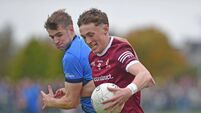The men tasked with keeping Mayo on green and red alert

The perception is a doctor runs on when someone picks up an injury. Maybe the physio gives a player a rub before and after a match. Simple?
Dr Séan Moffatt and his cousin Liam took on the role for James Horan in his first year with the Mayo team and have been with him every step of the way. At the time, Séan had been the Mayo minors and U21s doctor in previous seasons and was just after building the Ballina Medical Centre. Liam, a chartered physio and athletic trainer, was running the centre’s newly-formed Mayo Sports Clinic.
Both had played for Mayo at underage level having lost two U21 All-Ireland finals in 1994 and 1995. Self-confessed fans, they were assimilated into a management structure not seen before in red and green colours.
But for both men, the biggest eyeopener was the sacrifices players go through to compete at inter-county level. They were willing to match the players’ commitments. Constant medical reviews assess training load, fatigue and injury rates to prevent non-contact injuries. Prevention rather than cure.
Inevitably some slip through the net or pick up a long-term injury. When that happens the player enters a form of hell. Under Horan they are expected to attend all training sessions to do rehab work and also undergo regular evaluations to assess progress and return to play timelines. The carrot is a return to full training but the medical team makes that call.
“You recognise the emotional states based on the grief model where at first injured players are angry and frustrated because they put so much into it,” said Liam. “Then they might deny it. ‘It’s not that bad, I’ll get back for the game’ and they try and bargain with you to get half a game. Then they get depressed because they realise it ain’t going to happen for this game. Then they accept it and move on. There’s an emotional side to the injury. The hardest part of the job for me is seeing the disappointment, first hand, of players dealing with injuries.”
Those players’ emotions can be tricky but balancing a footballer’s wishes with a medic’s primary role, prioritising player welfare, is different.
Throughout the season they log each niggle and injury referring to ongoing studies within the GAA to see if there are any anomalies registered. Séan, having sat on the GAA’s medical and scientific committee, sees this as essential in monitoring players’ reaction to training loads and assisting the medical team in advising management about planning training schedules.
“In research, injury rates are recorded per 1,000 training hours. We would look at our own injury rates compared with established norms during the season. Liam also puts the data into the ongoing rolling data surveillance studies in the GAA.
“At a certain point in the season we were getting high enough rates of groin or hamstring injuries. We looked at everything, the time of the year, the amount of driving people were doing, back to back sessions and you find a trend and then say what can we do differently. 90% of our work is off the pitch behind the scenes.”
A multidisciplinary approach is key. Séan and Liam are supported by physio Martin McIntyre, masseur Joe Dawson and have strong links with strength and conditioning coach Ed Coughlan. “Our objective as a medical team is to prevent as many injuries before the injury occurs, and to assist conditioning coach Ed Coughlan and the wider management team regarding training load,” says Séan.
“Our aim is to reduce the amount of non-contact trauma injuries such as hamstring, groin and to an extent cruciate and ankle injuries. If a trauma injury occurs, I will assess it, image it and link up with the physio team for rehab and at the end stage we’d involve Ed with what the player can do.
“All the time we’re involving the management on an estimated return date and when they’re ready we modify the rehab so they come back, not at the level where they can return to play but at a level where they can execute the skills they have been pre-injury.”
In all, the job takes up a quarter of Séan and Liam’s working week at a time when they’re building their sports medicine practice at The Mayo Sports Clinic. And it brings pressures.
“It’s hard to enjoy game day,” said Séan. “It is a job. You’ve an inside knowledge into the level of preparation and effort put in and hope players perform and avoid injury. Part of our job is to know when a player is off. There’s a fine line between winning and losing you don’t want to be responsible for leaving someone on the pitch not 100%. Our job would be to tell the manager that.”
Liam added: “I’d be lying if I didn’t say there isn’t pressure regarding timeframes to get players right and Murphy’s Law says it’s always going to happen when you least want it.
“The key for us is to use a multi-disciplinary approach where everyone knows their area well.”













